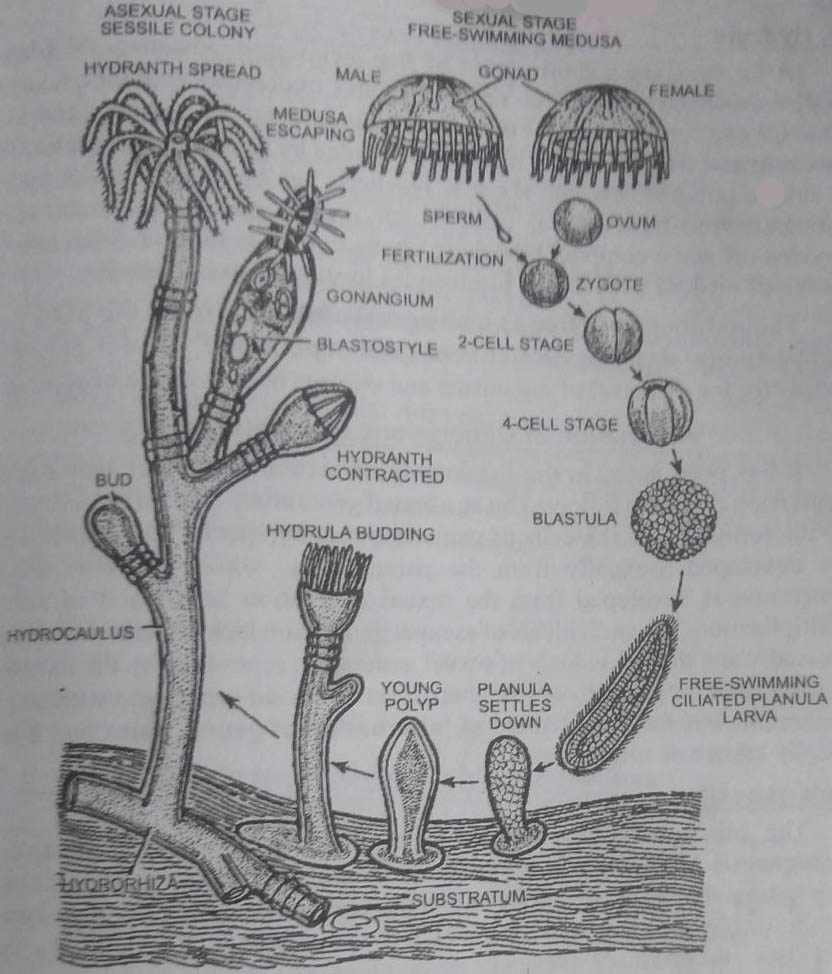Q.4. Give an account of the structure and life histology of obelia.
Or
What is meant by metagenesis explain it with reference to the life cycle of obelia?
Ans.4. Life-History of Obelia
Obelia colony reproduces asexually by budding producing hydranths and blastostyles. These represent an asexual generation. The blastostyles bear medusae which constitute the sexual or reproductive individuals possessing four groups of gonads. The gonads present on a medusa are of the same sex. These either produce sperms or eggs.
1. Fertilisation
Cross-fertilisation occurs as a rule and the ova are fertilised either inside the female medusa or in seawater. The sperms are carried to the ovum by water currents.

2. Development
The zygote undergoes repeated holoblastic and equal divisions and a blastula is formed. The blastula is hollow internally by a central cavity, the blastocoel. It is surrounded by a single layer of cells. Soon the blastocoel gets filled with the cells which are budded off from the wall of the blastula. Thus, a solid gastrula is formed. The outer layer of gastrula constitutes the ectoderm while the inner one forms the endoderm.
3. Planula Larva
Soon the gastrula elongates and its ectoderm cells develop cilia. This results in a free-swimming ciliated planula larva. Its anterior end is broader than the posterior end. Soon, the solid endoderm splits and enteron is formed. The planula larva, now, becomes a truly two-layered larva with outer ciliated ectoderm and inner endoderm.
4. Hydrula
After enjoying a short period of free-swimming existence, the planula settles down on some solid substratum and undergoes a metamorphosis. Its anterior end forms the basal disc for attachment and the posterior end forms manubrium with a terminal mouth, surrounded by a circle of tentacles. Thus a simple polyp or hydrula stage is reached. The basal part of the hydrula elongates into hydrorhiza, from which vertical and lateral branches are budded off and a complex branching obelia colony is formed. This, later on, develops medusa buds on the blastostyles to start sexual generation.
The occurrence of a free-swimming medusoid stage in the life-history of sedentary organisms like Obelia is of great significance since it provides a means for the dispersal of organisms and ensures a better change of survival.
Alternation of Generations and Metagenesis
It has been noted in the life-history of certain organisms that a sexual generation is always followed by an asexual generation. The former is initiated by the formation of sex-cells or gametes borne by special individuals which are developed asexually from the parent body, while the latter asexual generation is developed from the sexual generation as a result of asexual multiplication.
The individuals of asexual generation lack gonads and multiply asexually and the individuals of sexual generation reproduce by the formation of gametes. This phenomenon of alternation of sexual generation with asexual generation was formerly termed as ‘alternation of generations’ and is now usually known as metagenesis.
Metagenesis
The life history of the Obelia colony affords a very good example of metagenesis since there is a regular alternation of the asexual and sexual generations. The hydroid colony of Obelia, representing the sexual generation is followed by the medusoid form which is a sexual form. The hydroid colony is sexless and produces asexually by budding, giving rise to the polyps and blastostyles.
The latter develop medusae which are also budded off asexually. The medusae develop gonads, produce gametes by reduction division, which form zygote after fusion. Thus there is a regular metagenesis of an asexual hydroid form and a sexual medusoid form.
However, the alternation of generation exhibited by the life-history of Obelia is not true and typical since it is not an alternation between a diploid and a haploid generation as found in typical cases. In Obelia, only the gametes are haploid while the sexual medusoid form bearing gonads is diploid and so is the hydroid form. Secondly, the sexual generation does not arise from a single haploid cell. We can, therefore, conclude that the sexual form or medusa is specialised zooid bearing sex organs and leading a free-swimming existence to ensure the dispersal of gametes.
BSc 1st Year Lower Non-chordates Obelia Sample Model Practice Question Answer Papers